Caval Ridge Mine: Environmental Impact Assessment, Air Quality & More
VerifiedAdded on 2023/06/12
|7
|2227
|221
Report
AI Summary
This report provides an environmental impact assessment of the Caval Ridge Mine project, a multi-seam open-cut mine developed by BHP Billiton Mitsubishi Alliance Coal Operation Pty Ltd (BMA). The assessment covers project justification, sustainability, and air quality impacts. The project aims to contribute to Queensland's coal export industry while adhering to environmental regulations. Air quality is a key focus, with evaluations of dust emissions and mitigation measures using dispersion models and adherence to Queensland and Australian laws. The report identifies sensitive receptors and potential pollutants, proposing emission control measures to maintain air quality during construction and operation. Emission rates are derived from industry standards and site-specific parameters, with a focus on TSP, PM10, and PM2.5 particles. The assessment includes modeling for the Horse and Heyford pits and considers factors such as coal production, mining location, and overburden to minimize emissions. Desklib provides access to similar environmental reports and solved assignments for students.
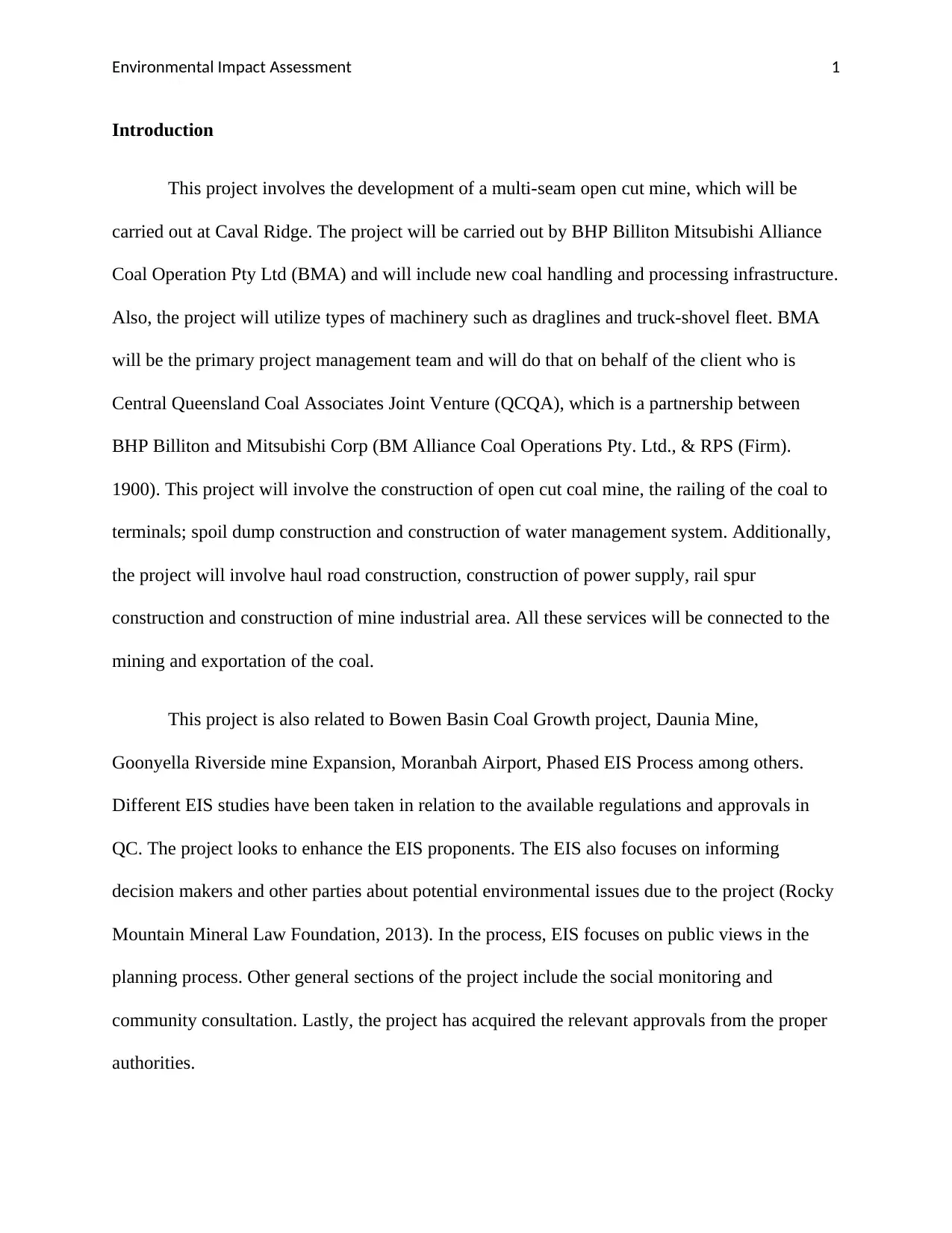
Environmental Impact Assessment 1
Introduction
This project involves the development of a multi-seam open cut mine, which will be
carried out at Caval Ridge. The project will be carried out by BHP Billiton Mitsubishi Alliance
Coal Operation Pty Ltd (BMA) and will include new coal handling and processing infrastructure.
Also, the project will utilize types of machinery such as draglines and truck-shovel fleet. BMA
will be the primary project management team and will do that on behalf of the client who is
Central Queensland Coal Associates Joint Venture (QCQA), which is a partnership between
BHP Billiton and Mitsubishi Corp (BM Alliance Coal Operations Pty. Ltd., & RPS (Firm).
1900). This project will involve the construction of open cut coal mine, the railing of the coal to
terminals; spoil dump construction and construction of water management system. Additionally,
the project will involve haul road construction, construction of power supply, rail spur
construction and construction of mine industrial area. All these services will be connected to the
mining and exportation of the coal.
This project is also related to Bowen Basin Coal Growth project, Daunia Mine,
Goonyella Riverside mine Expansion, Moranbah Airport, Phased EIS Process among others.
Different EIS studies have been taken in relation to the available regulations and approvals in
QC. The project looks to enhance the EIS proponents. The EIS also focuses on informing
decision makers and other parties about potential environmental issues due to the project (Rocky
Mountain Mineral Law Foundation, 2013). In the process, EIS focuses on public views in the
planning process. Other general sections of the project include the social monitoring and
community consultation. Lastly, the project has acquired the relevant approvals from the proper
authorities.
Introduction
This project involves the development of a multi-seam open cut mine, which will be
carried out at Caval Ridge. The project will be carried out by BHP Billiton Mitsubishi Alliance
Coal Operation Pty Ltd (BMA) and will include new coal handling and processing infrastructure.
Also, the project will utilize types of machinery such as draglines and truck-shovel fleet. BMA
will be the primary project management team and will do that on behalf of the client who is
Central Queensland Coal Associates Joint Venture (QCQA), which is a partnership between
BHP Billiton and Mitsubishi Corp (BM Alliance Coal Operations Pty. Ltd., & RPS (Firm).
1900). This project will involve the construction of open cut coal mine, the railing of the coal to
terminals; spoil dump construction and construction of water management system. Additionally,
the project will involve haul road construction, construction of power supply, rail spur
construction and construction of mine industrial area. All these services will be connected to the
mining and exportation of the coal.
This project is also related to Bowen Basin Coal Growth project, Daunia Mine,
Goonyella Riverside mine Expansion, Moranbah Airport, Phased EIS Process among others.
Different EIS studies have been taken in relation to the available regulations and approvals in
QC. The project looks to enhance the EIS proponents. The EIS also focuses on informing
decision makers and other parties about potential environmental issues due to the project (Rocky
Mountain Mineral Law Foundation, 2013). In the process, EIS focuses on public views in the
planning process. Other general sections of the project include the social monitoring and
community consultation. Lastly, the project has acquired the relevant approvals from the proper
authorities.
Paraphrase This Document
Need a fresh take? Get an instant paraphrase of this document with our AI Paraphraser
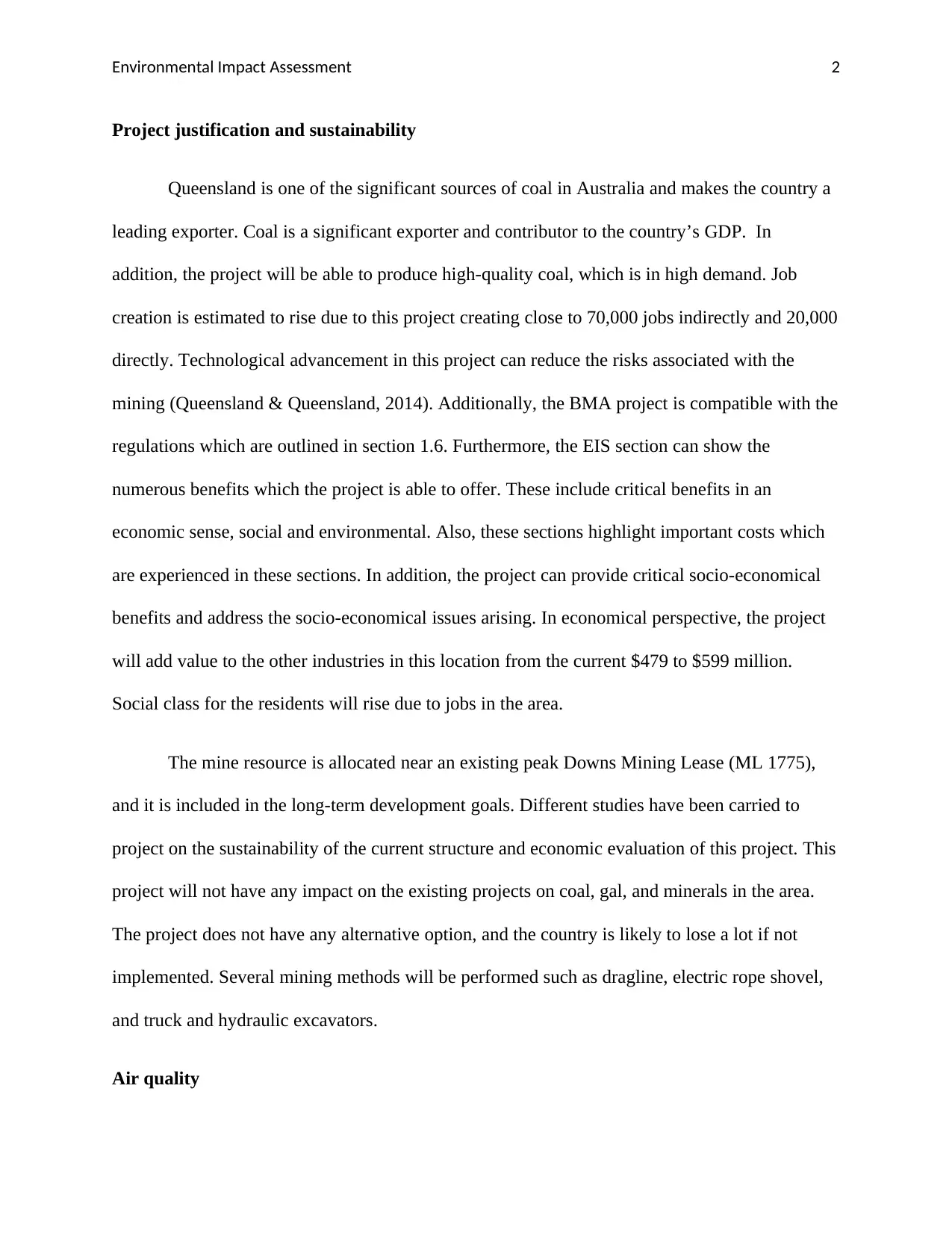
Environmental Impact Assessment 2
Project justification and sustainability
Queensland is one of the significant sources of coal in Australia and makes the country a
leading exporter. Coal is a significant exporter and contributor to the country’s GDP. In
addition, the project will be able to produce high-quality coal, which is in high demand. Job
creation is estimated to rise due to this project creating close to 70,000 jobs indirectly and 20,000
directly. Technological advancement in this project can reduce the risks associated with the
mining (Queensland & Queensland, 2014). Additionally, the BMA project is compatible with the
regulations which are outlined in section 1.6. Furthermore, the EIS section can show the
numerous benefits which the project is able to offer. These include critical benefits in an
economic sense, social and environmental. Also, these sections highlight important costs which
are experienced in these sections. In addition, the project can provide critical socio-economical
benefits and address the socio-economical issues arising. In economical perspective, the project
will add value to the other industries in this location from the current $479 to $599 million.
Social class for the residents will rise due to jobs in the area.
The mine resource is allocated near an existing peak Downs Mining Lease (ML 1775),
and it is included in the long-term development goals. Different studies have been carried to
project on the sustainability of the current structure and economic evaluation of this project. This
project will not have any impact on the existing projects on coal, gal, and minerals in the area.
The project does not have any alternative option, and the country is likely to lose a lot if not
implemented. Several mining methods will be performed such as dragline, electric rope shovel,
and truck and hydraulic excavators.
Air quality
Project justification and sustainability
Queensland is one of the significant sources of coal in Australia and makes the country a
leading exporter. Coal is a significant exporter and contributor to the country’s GDP. In
addition, the project will be able to produce high-quality coal, which is in high demand. Job
creation is estimated to rise due to this project creating close to 70,000 jobs indirectly and 20,000
directly. Technological advancement in this project can reduce the risks associated with the
mining (Queensland & Queensland, 2014). Additionally, the BMA project is compatible with the
regulations which are outlined in section 1.6. Furthermore, the EIS section can show the
numerous benefits which the project is able to offer. These include critical benefits in an
economic sense, social and environmental. Also, these sections highlight important costs which
are experienced in these sections. In addition, the project can provide critical socio-economical
benefits and address the socio-economical issues arising. In economical perspective, the project
will add value to the other industries in this location from the current $479 to $599 million.
Social class for the residents will rise due to jobs in the area.
The mine resource is allocated near an existing peak Downs Mining Lease (ML 1775),
and it is included in the long-term development goals. Different studies have been carried to
project on the sustainability of the current structure and economic evaluation of this project. This
project will not have any impact on the existing projects on coal, gal, and minerals in the area.
The project does not have any alternative option, and the country is likely to lose a lot if not
implemented. Several mining methods will be performed such as dragline, electric rope shovel,
and truck and hydraulic excavators.
Air quality
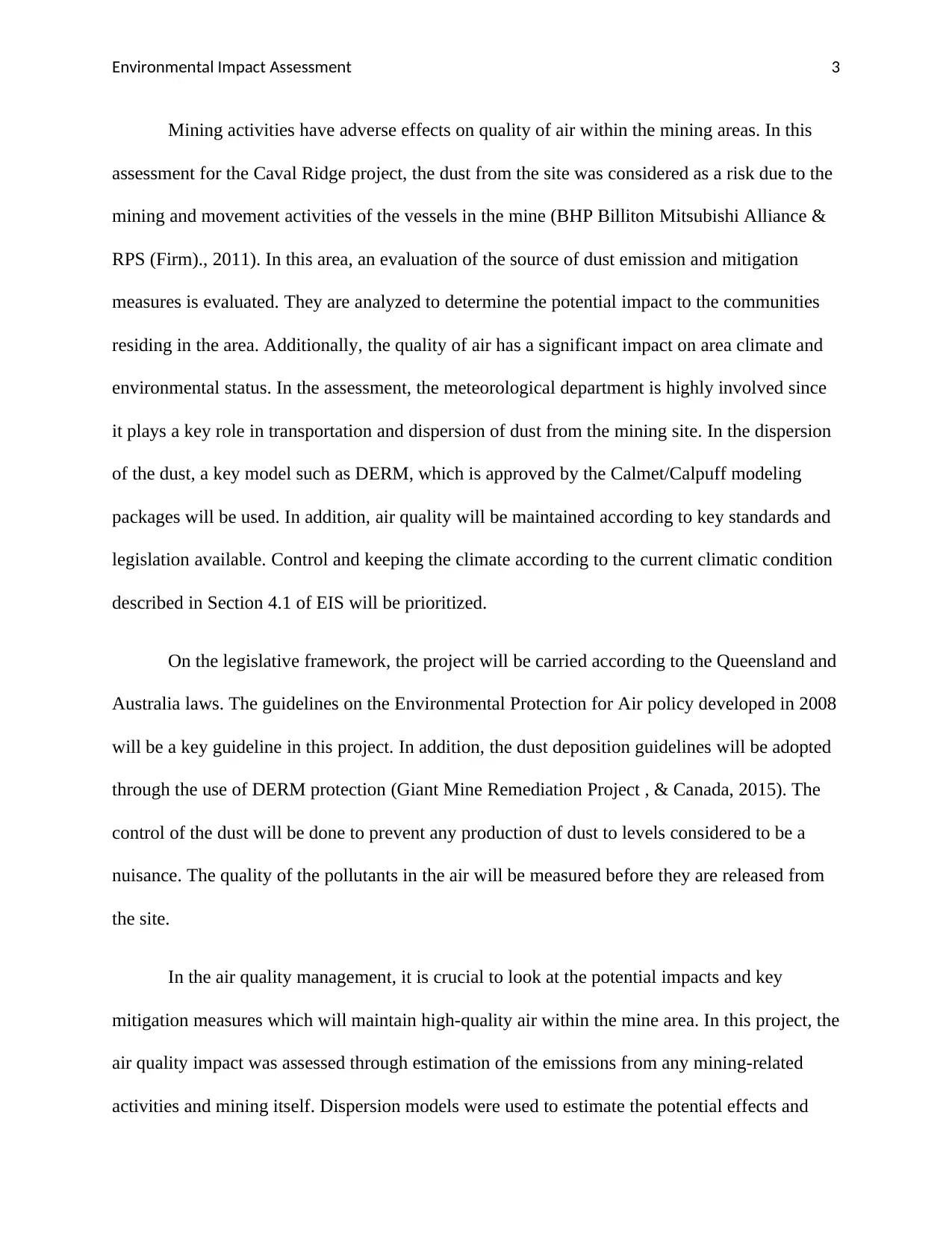
Environmental Impact Assessment 3
Mining activities have adverse effects on quality of air within the mining areas. In this
assessment for the Caval Ridge project, the dust from the site was considered as a risk due to the
mining and movement activities of the vessels in the mine (BHP Billiton Mitsubishi Alliance &
RPS (Firm)., 2011). In this area, an evaluation of the source of dust emission and mitigation
measures is evaluated. They are analyzed to determine the potential impact to the communities
residing in the area. Additionally, the quality of air has a significant impact on area climate and
environmental status. In the assessment, the meteorological department is highly involved since
it plays a key role in transportation and dispersion of dust from the mining site. In the dispersion
of the dust, a key model such as DERM, which is approved by the Calmet/Calpuff modeling
packages will be used. In addition, air quality will be maintained according to key standards and
legislation available. Control and keeping the climate according to the current climatic condition
described in Section 4.1 of EIS will be prioritized.
On the legislative framework, the project will be carried according to the Queensland and
Australia laws. The guidelines on the Environmental Protection for Air policy developed in 2008
will be a key guideline in this project. In addition, the dust deposition guidelines will be adopted
through the use of DERM protection (Giant Mine Remediation Project , & Canada, 2015). The
control of the dust will be done to prevent any production of dust to levels considered to be a
nuisance. The quality of the pollutants in the air will be measured before they are released from
the site.
In the air quality management, it is crucial to look at the potential impacts and key
mitigation measures which will maintain high-quality air within the mine area. In this project, the
air quality impact was assessed through estimation of the emissions from any mining-related
activities and mining itself. Dispersion models were used to estimate the potential effects and
Mining activities have adverse effects on quality of air within the mining areas. In this
assessment for the Caval Ridge project, the dust from the site was considered as a risk due to the
mining and movement activities of the vessels in the mine (BHP Billiton Mitsubishi Alliance &
RPS (Firm)., 2011). In this area, an evaluation of the source of dust emission and mitigation
measures is evaluated. They are analyzed to determine the potential impact to the communities
residing in the area. Additionally, the quality of air has a significant impact on area climate and
environmental status. In the assessment, the meteorological department is highly involved since
it plays a key role in transportation and dispersion of dust from the mining site. In the dispersion
of the dust, a key model such as DERM, which is approved by the Calmet/Calpuff modeling
packages will be used. In addition, air quality will be maintained according to key standards and
legislation available. Control and keeping the climate according to the current climatic condition
described in Section 4.1 of EIS will be prioritized.
On the legislative framework, the project will be carried according to the Queensland and
Australia laws. The guidelines on the Environmental Protection for Air policy developed in 2008
will be a key guideline in this project. In addition, the dust deposition guidelines will be adopted
through the use of DERM protection (Giant Mine Remediation Project , & Canada, 2015). The
control of the dust will be done to prevent any production of dust to levels considered to be a
nuisance. The quality of the pollutants in the air will be measured before they are released from
the site.
In the air quality management, it is crucial to look at the potential impacts and key
mitigation measures which will maintain high-quality air within the mine area. In this project, the
air quality impact was assessed through estimation of the emissions from any mining-related
activities and mining itself. Dispersion models were used to estimate the potential effects and
⊘ This is a preview!⊘
Do you want full access?
Subscribe today to unlock all pages.

Trusted by 1+ million students worldwide
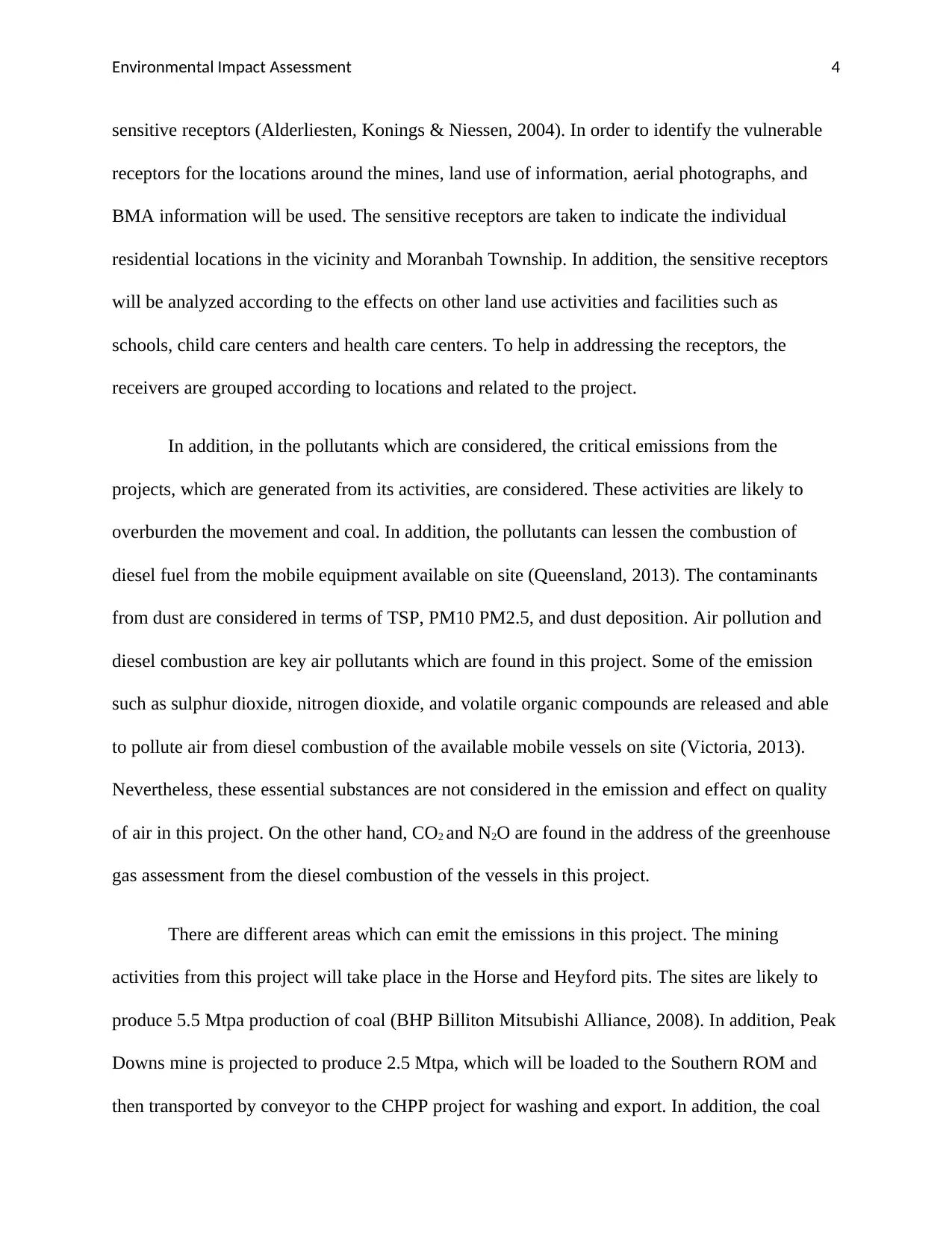
Environmental Impact Assessment 4
sensitive receptors (Alderliesten, Konings & Niessen, 2004). In order to identify the vulnerable
receptors for the locations around the mines, land use of information, aerial photographs, and
BMA information will be used. The sensitive receptors are taken to indicate the individual
residential locations in the vicinity and Moranbah Township. In addition, the sensitive receptors
will be analyzed according to the effects on other land use activities and facilities such as
schools, child care centers and health care centers. To help in addressing the receptors, the
receivers are grouped according to locations and related to the project.
In addition, in the pollutants which are considered, the critical emissions from the
projects, which are generated from its activities, are considered. These activities are likely to
overburden the movement and coal. In addition, the pollutants can lessen the combustion of
diesel fuel from the mobile equipment available on site (Queensland, 2013). The contaminants
from dust are considered in terms of TSP, PM10 PM2.5, and dust deposition. Air pollution and
diesel combustion are key air pollutants which are found in this project. Some of the emission
such as sulphur dioxide, nitrogen dioxide, and volatile organic compounds are released and able
to pollute air from diesel combustion of the available mobile vessels on site (Victoria, 2013).
Nevertheless, these essential substances are not considered in the emission and effect on quality
of air in this project. On the other hand, CO2 and N2O are found in the address of the greenhouse
gas assessment from the diesel combustion of the vessels in this project.
There are different areas which can emit the emissions in this project. The mining
activities from this project will take place in the Horse and Heyford pits. The sites are likely to
produce 5.5 Mtpa production of coal (BHP Billiton Mitsubishi Alliance, 2008). In addition, Peak
Downs mine is projected to produce 2.5 Mtpa, which will be loaded to the Southern ROM and
then transported by conveyor to the CHPP project for washing and export. In addition, the coal
sensitive receptors (Alderliesten, Konings & Niessen, 2004). In order to identify the vulnerable
receptors for the locations around the mines, land use of information, aerial photographs, and
BMA information will be used. The sensitive receptors are taken to indicate the individual
residential locations in the vicinity and Moranbah Township. In addition, the sensitive receptors
will be analyzed according to the effects on other land use activities and facilities such as
schools, child care centers and health care centers. To help in addressing the receptors, the
receivers are grouped according to locations and related to the project.
In addition, in the pollutants which are considered, the critical emissions from the
projects, which are generated from its activities, are considered. These activities are likely to
overburden the movement and coal. In addition, the pollutants can lessen the combustion of
diesel fuel from the mobile equipment available on site (Queensland, 2013). The contaminants
from dust are considered in terms of TSP, PM10 PM2.5, and dust deposition. Air pollution and
diesel combustion are key air pollutants which are found in this project. Some of the emission
such as sulphur dioxide, nitrogen dioxide, and volatile organic compounds are released and able
to pollute air from diesel combustion of the available mobile vessels on site (Victoria, 2013).
Nevertheless, these essential substances are not considered in the emission and effect on quality
of air in this project. On the other hand, CO2 and N2O are found in the address of the greenhouse
gas assessment from the diesel combustion of the vessels in this project.
There are different areas which can emit the emissions in this project. The mining
activities from this project will take place in the Horse and Heyford pits. The sites are likely to
produce 5.5 Mtpa production of coal (BHP Billiton Mitsubishi Alliance, 2008). In addition, Peak
Downs mine is projected to produce 2.5 Mtpa, which will be loaded to the Southern ROM and
then transported by conveyor to the CHPP project for washing and export. In addition, the coal
Paraphrase This Document
Need a fresh take? Get an instant paraphrase of this document with our AI Paraphraser
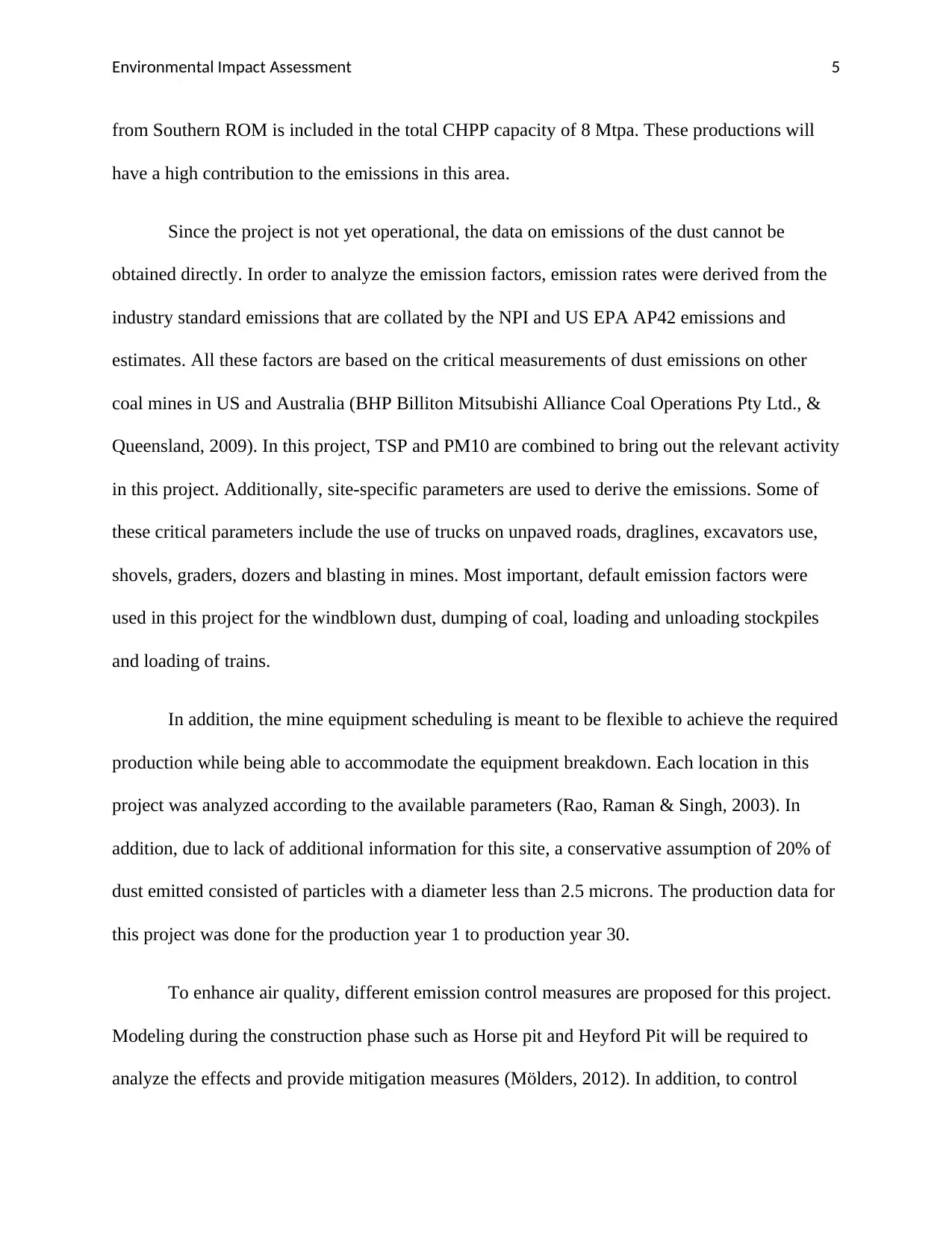
Environmental Impact Assessment 5
from Southern ROM is included in the total CHPP capacity of 8 Mtpa. These productions will
have a high contribution to the emissions in this area.
Since the project is not yet operational, the data on emissions of the dust cannot be
obtained directly. In order to analyze the emission factors, emission rates were derived from the
industry standard emissions that are collated by the NPI and US EPA AP42 emissions and
estimates. All these factors are based on the critical measurements of dust emissions on other
coal mines in US and Australia (BHP Billiton Mitsubishi Alliance Coal Operations Pty Ltd., &
Queensland, 2009). In this project, TSP and PM10 are combined to bring out the relevant activity
in this project. Additionally, site-specific parameters are used to derive the emissions. Some of
these critical parameters include the use of trucks on unpaved roads, draglines, excavators use,
shovels, graders, dozers and blasting in mines. Most important, default emission factors were
used in this project for the windblown dust, dumping of coal, loading and unloading stockpiles
and loading of trains.
In addition, the mine equipment scheduling is meant to be flexible to achieve the required
production while being able to accommodate the equipment breakdown. Each location in this
project was analyzed according to the available parameters (Rao, Raman & Singh, 2003). In
addition, due to lack of additional information for this site, a conservative assumption of 20% of
dust emitted consisted of particles with a diameter less than 2.5 microns. The production data for
this project was done for the production year 1 to production year 30.
To enhance air quality, different emission control measures are proposed for this project.
Modeling during the construction phase such as Horse pit and Heyford Pit will be required to
analyze the effects and provide mitigation measures (Mölders, 2012). In addition, to control
from Southern ROM is included in the total CHPP capacity of 8 Mtpa. These productions will
have a high contribution to the emissions in this area.
Since the project is not yet operational, the data on emissions of the dust cannot be
obtained directly. In order to analyze the emission factors, emission rates were derived from the
industry standard emissions that are collated by the NPI and US EPA AP42 emissions and
estimates. All these factors are based on the critical measurements of dust emissions on other
coal mines in US and Australia (BHP Billiton Mitsubishi Alliance Coal Operations Pty Ltd., &
Queensland, 2009). In this project, TSP and PM10 are combined to bring out the relevant activity
in this project. Additionally, site-specific parameters are used to derive the emissions. Some of
these critical parameters include the use of trucks on unpaved roads, draglines, excavators use,
shovels, graders, dozers and blasting in mines. Most important, default emission factors were
used in this project for the windblown dust, dumping of coal, loading and unloading stockpiles
and loading of trains.
In addition, the mine equipment scheduling is meant to be flexible to achieve the required
production while being able to accommodate the equipment breakdown. Each location in this
project was analyzed according to the available parameters (Rao, Raman & Singh, 2003). In
addition, due to lack of additional information for this site, a conservative assumption of 20% of
dust emitted consisted of particles with a diameter less than 2.5 microns. The production data for
this project was done for the production year 1 to production year 30.
To enhance air quality, different emission control measures are proposed for this project.
Modeling during the construction phase such as Horse pit and Heyford Pit will be required to
analyze the effects and provide mitigation measures (Mölders, 2012). In addition, to control
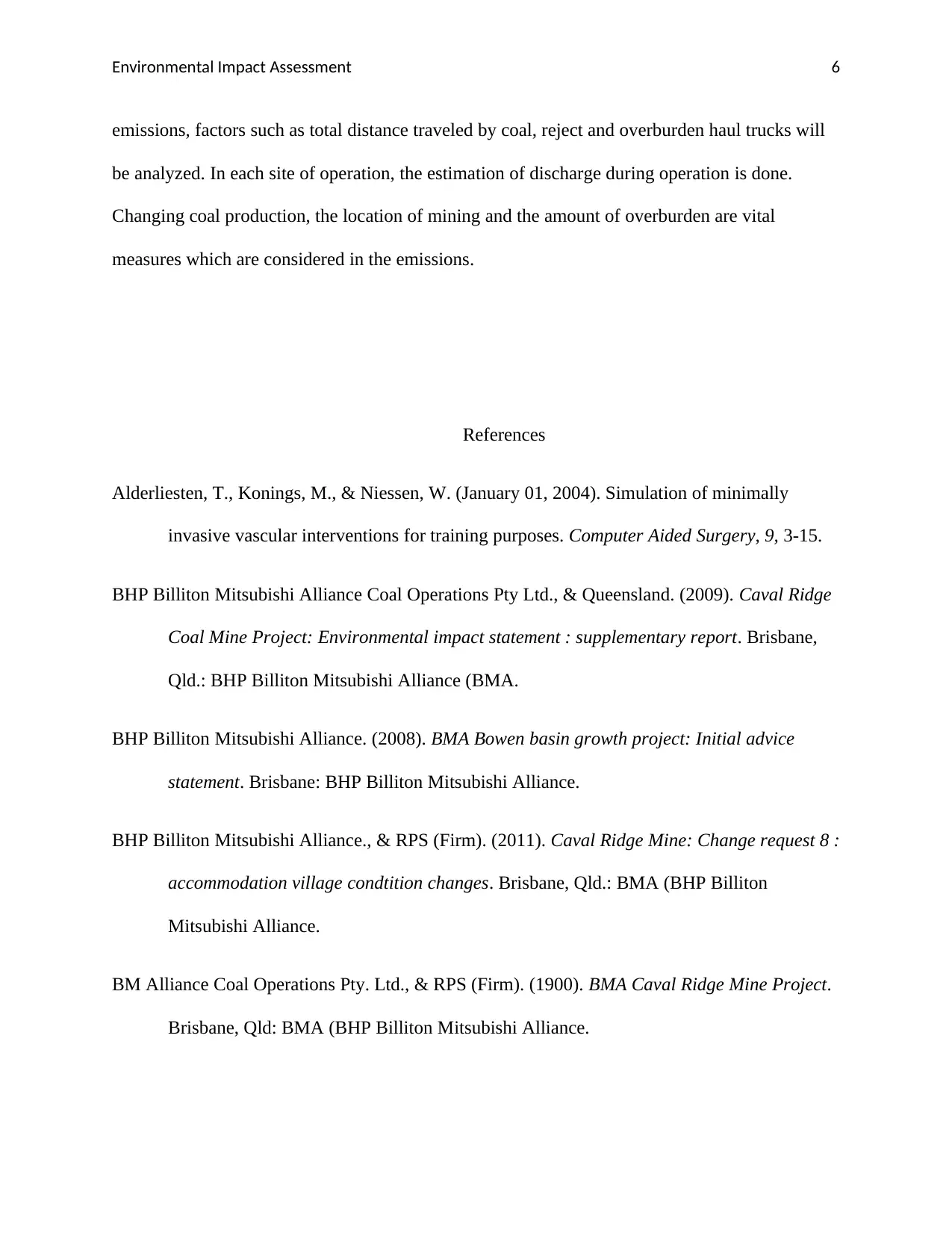
Environmental Impact Assessment 6
emissions, factors such as total distance traveled by coal, reject and overburden haul trucks will
be analyzed. In each site of operation, the estimation of discharge during operation is done.
Changing coal production, the location of mining and the amount of overburden are vital
measures which are considered in the emissions.
References
Alderliesten, T., Konings, M., & Niessen, W. (January 01, 2004). Simulation of minimally
invasive vascular interventions for training purposes. Computer Aided Surgery, 9, 3-15.
BHP Billiton Mitsubishi Alliance Coal Operations Pty Ltd., & Queensland. (2009). Caval Ridge
Coal Mine Project: Environmental impact statement : supplementary report. Brisbane,
Qld.: BHP Billiton Mitsubishi Alliance (BMA.
BHP Billiton Mitsubishi Alliance. (2008). BMA Bowen basin growth project: Initial advice
statement. Brisbane: BHP Billiton Mitsubishi Alliance.
BHP Billiton Mitsubishi Alliance., & RPS (Firm). (2011). Caval Ridge Mine: Change request 8 :
accommodation village condtition changes. Brisbane, Qld.: BMA (BHP Billiton
Mitsubishi Alliance.
BM Alliance Coal Operations Pty. Ltd., & RPS (Firm). (1900). BMA Caval Ridge Mine Project.
Brisbane, Qld: BMA (BHP Billiton Mitsubishi Alliance.
emissions, factors such as total distance traveled by coal, reject and overburden haul trucks will
be analyzed. In each site of operation, the estimation of discharge during operation is done.
Changing coal production, the location of mining and the amount of overburden are vital
measures which are considered in the emissions.
References
Alderliesten, T., Konings, M., & Niessen, W. (January 01, 2004). Simulation of minimally
invasive vascular interventions for training purposes. Computer Aided Surgery, 9, 3-15.
BHP Billiton Mitsubishi Alliance Coal Operations Pty Ltd., & Queensland. (2009). Caval Ridge
Coal Mine Project: Environmental impact statement : supplementary report. Brisbane,
Qld.: BHP Billiton Mitsubishi Alliance (BMA.
BHP Billiton Mitsubishi Alliance. (2008). BMA Bowen basin growth project: Initial advice
statement. Brisbane: BHP Billiton Mitsubishi Alliance.
BHP Billiton Mitsubishi Alliance., & RPS (Firm). (2011). Caval Ridge Mine: Change request 8 :
accommodation village condtition changes. Brisbane, Qld.: BMA (BHP Billiton
Mitsubishi Alliance.
BM Alliance Coal Operations Pty. Ltd., & RPS (Firm). (1900). BMA Caval Ridge Mine Project.
Brisbane, Qld: BMA (BHP Billiton Mitsubishi Alliance.
⊘ This is a preview!⊘
Do you want full access?
Subscribe today to unlock all pages.

Trusted by 1+ million students worldwide
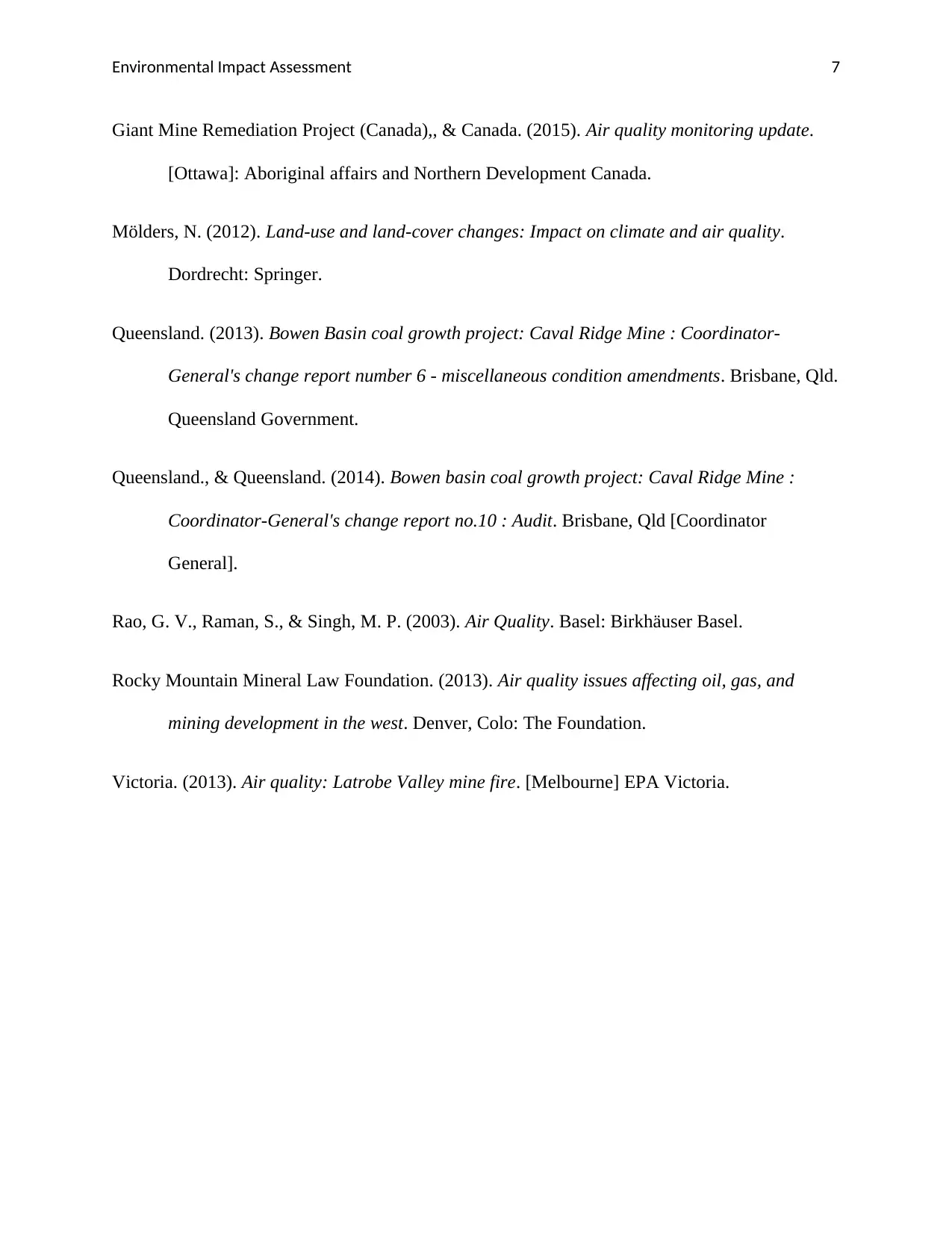
Environmental Impact Assessment 7
Giant Mine Remediation Project (Canada),, & Canada. (2015). Air quality monitoring update.
[Ottawa]: Aboriginal affairs and Northern Development Canada.
Mölders, N. (2012). Land-use and land-cover changes: Impact on climate and air quality.
Dordrecht: Springer.
Queensland. (2013). Bowen Basin coal growth project: Caval Ridge Mine : Coordinator-
General's change report number 6 - miscellaneous condition amendments. Brisbane, Qld.
Queensland Government.
Queensland., & Queensland. (2014). Bowen basin coal growth project: Caval Ridge Mine :
Coordinator-General's change report no.10 : Audit. Brisbane, Qld [Coordinator
General].
Rao, G. V., Raman, S., & Singh, M. P. (2003). Air Quality. Basel: Birkhäuser Basel.
Rocky Mountain Mineral Law Foundation. (2013). Air quality issues affecting oil, gas, and
mining development in the west. Denver, Colo: The Foundation.
Victoria. (2013). Air quality: Latrobe Valley mine fire. [Melbourne] EPA Victoria.
Giant Mine Remediation Project (Canada),, & Canada. (2015). Air quality monitoring update.
[Ottawa]: Aboriginal affairs and Northern Development Canada.
Mölders, N. (2012). Land-use and land-cover changes: Impact on climate and air quality.
Dordrecht: Springer.
Queensland. (2013). Bowen Basin coal growth project: Caval Ridge Mine : Coordinator-
General's change report number 6 - miscellaneous condition amendments. Brisbane, Qld.
Queensland Government.
Queensland., & Queensland. (2014). Bowen basin coal growth project: Caval Ridge Mine :
Coordinator-General's change report no.10 : Audit. Brisbane, Qld [Coordinator
General].
Rao, G. V., Raman, S., & Singh, M. P. (2003). Air Quality. Basel: Birkhäuser Basel.
Rocky Mountain Mineral Law Foundation. (2013). Air quality issues affecting oil, gas, and
mining development in the west. Denver, Colo: The Foundation.
Victoria. (2013). Air quality: Latrobe Valley mine fire. [Melbourne] EPA Victoria.
1 out of 7
Your All-in-One AI-Powered Toolkit for Academic Success.
+13062052269
info@desklib.com
Available 24*7 on WhatsApp / Email
![[object Object]](/_next/static/media/star-bottom.7253800d.svg)
Unlock your academic potential
Copyright © 2020–2025 A2Z Services. All Rights Reserved. Developed and managed by ZUCOL.
